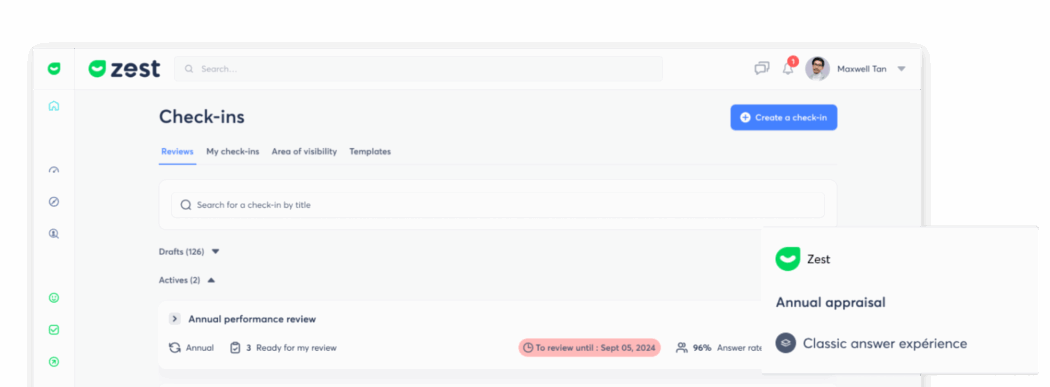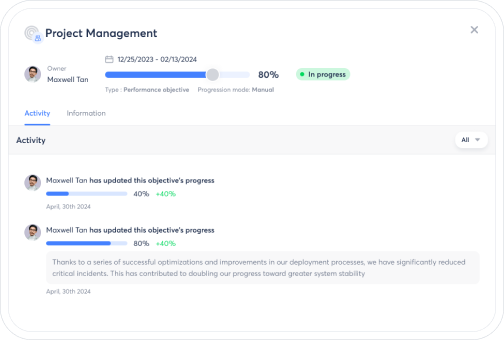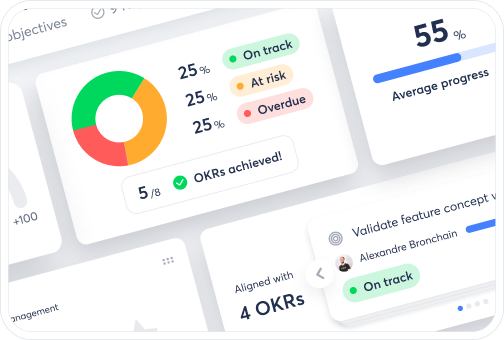Annual Performance Review
preparation, process and follow-up

Annual review: what exactly are we talking about?
What is an annual performance review?
The annual performance review (also known as the one-on-one review) is a management ritual designed to formalize a discussion between the employee and their manager. It provides an opportunity to reflect on the past year, evaluate the employee’s performance, and set future objectives.
It is also a valuable moment to assess skills, training needs, and development opportunities.

How the annual review unfolds
 Year in review
Year in review
Assess the employee’s quantitative and qualitative performance and results. Identify key achievements and the level of goal completion.
 Goal setting
Goal setting
Set individual goals for the upcoming year or review period. Align individual goals with the company’s collective objectives.
 Skills assessment
Skills assessment
Identify key skills, track skill progression, and assess current skill levels.
 Career development opportunities
Career development opportunities
Document development aspirations and discuss the career path and available opportunities.
Who should conduct annual performance reviews?
The role of the direct manager
The review is conducted between the employee and their direct manager or immediate supervisor. Depending on the size of the company, it may be led by the business owner (for companies with fewer than 10 employees), the direct manager, or the HR manager in larger organizations.

The employee’s role
The employee prepares for the annual review by reflecting on their year, achievements, and needs.
They actively contribute by sharing their feedback, goals, and suggestions for improvement.
This two-way conversation supports professional growth and overall well-being at work.

Simplify annual reviews with Zest
Zest helps you digitize, modernize, and simplify the annual performance review
Modernize your management with new agile and recurring rituals.
1
Quickly create your interview templates
Customize them to your needs using our library of templates
2
Set and track your goals in just 3 clicks
Adjust in real time to on-the-ground realities and evolving business needs
3
Easily schedule regular check-ins
Provide real-time feedback
Key success factors for the annual performance review
 Proper preparation and communication
Proper preparation and communication
Use an interview framework to cover all key topics and structure the conversation. Communicate the interview process and evaluation criteria clearly to ensure a fair and objective assessment.
 Tools to support you
Tools to support you
The use of digital tools makes it easier to prepare, collect, and analyze data. The benefits are numerous, including simplified historical comparisons and AI-powered analysis.
 Required documents
Required documents
It is recommended to provide your employees with an invitation ahead of the interview, followed by a summary report that is reviewed and approved by both parties.
Best practices to keep in mind
To ensure the campaign is effective, several key elements are essential :
- Simplify the interview structure to avoid making the process burdensome. Use our template and practical tips.
- Pay close attention to how you express things, with a focus on empathy and open dialogue.
- Lead and track objectives throughout the year. See our examples.
- Modernize management practices.

When should you launch your Annual Review campaign?

Annual review campaigns are typically held at the end of the year, between October and December. Spacing them 12 months apart ensures consistent evaluation from one year to the next. It’s best practice to conduct all annual reviews within the same time frame.
In addition to the yearly campaign, regular 1:1 check-ins are recommended throughout the year.
Discover Zest’s Review feature to manage all your performance reviews.
 Easy
Easy
Easy-to-set-up campaigns: ready-to-use templates, auto-calculated variables, seamless integration with goals, skills, and training needs collection.
 Mobile
Mobile
The only mobile app designed to include your frontline teams, with no professional email or computer required.
 Multi-language
Multi-language
Multi-language campaigns to simplify interview logistics at the international level. Available in 25 languages.
 Multi-contributor
Multi-contributor
A modern multi-contributor review (N+1, N+2, project leads, experts, 360° feedback, etc.)
Practical side
For managers
Easy to use
Real-time visibility on key team KPIs
Access to review history directly in Zest or via export

For employees
Streamlined and personalized review experience
Feedback and continuous improvement
Data-driven evaluation based on concrete inputs

What skills are evaluated during the annual review?
The annual review is an opportunity to reflect on the year’s accomplishments and assess progress toward previously defined goals.
Beyond evaluating performance alone, the review also covers both technical and interpersonal skills.
Technical skills, or « hard skills », such as software proficiency, foreign language ability or legal knowledge, are assessed based on level of mastery and improvement over the review period.
Interpersonal skills, or « soft skills », such as communication, leadership or teamwork, are also reviewed.
Finally, employee initiatives and contributions are acknowledged, along with potential development and growth opportunities.


What happens after the annual performance review?
Once the review is finalized, it’s essential to plan follow-up actions and implement concrete action plans. Too often, the lack of post-review follow-up leads to inefficiency and employee frustration.
To avoid this, scheduling regular 1:1 check-ins and maintaining ongoing dialogue is considered a best practice.
FAQ
Have questions?
After welcoming the employee, the individual review typically follows these steps:
– Review of the past year
– Definition of new objectives
– Evaluation of skills and training needs
– Discussion of career goals and development opportunities
– Summary of the conversation
La question de la rémunération est naturellement abordée lors de l’entretien individuel, mais ne devrait pas être un catalyseur des tensions. La façon la plus sereine d’aborder le sujet est de le lier aux performances passées et aux compétences, ainsi qu’à des facteurs exogènes tels que la position de l’entreprise sur son marché, ses perspectives de croissance etc.
No, an employee generally cannot refuse to participate in an annual performance review if the employer has decided to implement it.
Questions may cover the review of past activities, current projects, achievement of objectives, skill development, and career progression.
You can also take a broader perspective by asking about the company’s position in its market.
More Zest news

Reducing Turnover: 5 Tips to Retain Your Talent

eNPS (Employee Net Promoter Score) as a tool for measuring employee commitment?










